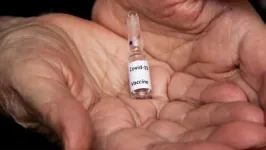(Press-News.org) PITTSBURGH, May 7, 2021 - In a paper published today in Nature Communications, an international group of collaborators led by researchers at UPMC Children's Hospital of Pittsburgh have identified a genetic cause of a rare neurological disorder marked by developmental delay and loss of coordination, or ataxia.
The disorder, scientists found, is caused by mutations in a protein called GEMIN5--one of the key building blocks of a protein complex that controls RNA metabolism in neurons. No mutations in GEMIN5 were previously linked to any genetic disease.
"It's just like building a house," said senior author Udai Pandey, Ph.D., associate professor of pediatrics, human genetics and neurology at the University of Pittsburgh School of Medicine. "You take out the most important brick at the base and the whole building falls apart."
GEMIN5 is part of a protein complex that regulates a slew of important cellular processes, including development of specialized outgrowths from nerve cells called dendrites and axons. Interestingly, mutations in another key protein of the complex, named survival motor neuron protein, cause a different devastating disorder--spinal muscular atrophy.
To gather material for the study, Pittsburgh researchers contacted pediatricians, geneticists and neurologists from all over the globe, eventually collecting data from 30 patient families in 12 different countries.
Because isolating live neurons from people isn't possible, researchers had to come up with another way of getting samples for future testing. They collected blood samples from pediatric patients who were referred to neurogenetic clinics with undiagnosed neurological symptoms. Blood samples were then processed to isolate cells that, with careful tinkering in the lab, were reprogrammed into neurons.
After comparing genetic material of reprogrammed neurons from sick children with that of unaffected relatives, scientists linked neurologic manifestations of the disease to 26 mutations in the GEMIN5 gene that cause damage to the structure of the protein.
"Children came into the clinic with non-specific symptoms, such as developmental delay and abnormal gait. Their doctors ran all the possible tests, including assessing a child's metabolic function, to no avail--their conditions had no easy explanation," said Deepa Rajan, M.D., assistant professor of pediatrics, Pitt School of Medicine, neurologist at UPMC Children's Hospital and a co-first author of the study. "It was not until we did an extensive genome analysis that we found that these patients had mutations in the GEMIN5 gene."
"Many genetic disorders seem individually rare, but collectively they are relatively common," added Rajan, who also is director of the Neurogenetics Clinic at UPMC Children's Hospital. "We now are able to harness next-generation technology to help diagnose previously undiagnosed children, and each new gene discovery is the start of the journey to understanding each of these diseases better."
Additional experiments linked damage to GEMIN5 protein to disease manifestations more definitively. Scientists found that depleting an analog of human neuronal GEMIN5 protein in fruit flies was deadly if it happened in early stages of the fly's life cycle, or drastically delayed its development if such disruption happened later.
"The most exciting part of being a researcher is working on a project that directly helps families," said Pandey. "We are hopeful that because of our study, neurologists will now consider testing for GEMIN5 mutations and that labs will include GEMIN5 in their testing for ataxic disorders. Genetic diseases are challenging to identify and treat, but if we find a cure, it will make a massive difference in someone's life."
INFORMATION:
Other authors on the manuscript include Sukhleen Kour, Ph.D., Tyler Fortuna, Ph.D., Eric Anderson, Ph.D., Dhivyaa Rajasundaram, Ph.D., and Caroline Ward, all of Pitt, among 70 total authors.
This work was supported by a University of Pittsburgh Children's Neuroscience Institute research grant.
To read this release online or share it, visit https://www.upmc.com/media/news/050721-Pandey-GEMIN5 [when embargo lifts].
About UPMC Children's Hospital of Pittsburgh
Regionally, nationally, and globally, UPMC Children's Hospital of Pittsburgh is a leader in the treatment of childhood conditions and diseases, a pioneer in the development of new and improved therapies, and a top educator of the next generation of pediatricians and pediatric subspecialists. With generous community support, UPMC Children's Hospital has fulfilled this mission since its founding in 1890. UPMC Children's is recognized consistently for its clinical, research, educational, and advocacy-related accomplishments, including ranking in the top 10 on the 2020-2021 U.S. News & World Report Honor Roll of America's Best Children's Hospitals. UPMC Children's also ranks 15th among children's hospitals and schools of medicine in funding for pediatric research provided by the National Institutes of Health (FY2019).
About the University of Pittsburgh Schools of the Health Sciences
The University of Pittsburgh Schools of the Health Sciences include the schools of Medicine, Nursing, Dental Medicine, Pharmacy, Health and Rehabilitation Sciences and the Graduate School of Public Health. The schools serve as the academic partner to the UPMC (University of Pittsburgh Medical Center). Together, their combined mission is to train tomorrow's health care specialists and biomedical scientists, engage in groundbreaking research that will advance understanding of the causes and treatments of disease and participate in the delivery of outstanding patient care. Since 1998, Pitt and its affiliated university faculty have ranked among the top 10 educational institutions in grant support from the National Institutes of Health. For additional information about the Schools of the Health Sciences, please visit http://www.health.pitt.edu.
http://www.upmc.com/media
Contact: Anastasia Gorelova
Mobile: 412-491-9411
E-mail: GorelovaA@upmc.edu
Contact: Andrea Kunicky
Mobile: 412-552-7448
E-mail: KunickyA@upmc.edu
Luxembourg, 7 May 2021 - In a new position statement, Alzheimer Europe has issued a call for prioritisation of people with dementia and their carers in national COVID-19 vaccination strategies, urging governments to recognise the disproportionate effect of the pandemic on these groups.
Alzheimer Europe has today issued a call for people with dementia and their carers to be given priority in the ongoing COVID-19 vaccination campaigns across Europe.
In its position statement, Alzheimer Europe notes that people with dementia have almost twice the risk for developing COVID-19 compared to their ...
Systemic inequalities mean that low-income households in London are more likely to be exposed to higher levels of indoor air pollution, according to a report by UCL researchers.
The biggest factors are the quality of housing and the characteristics of the surrounding environment, taking location and levels of outdoor air pollution into account - factors beyond occupants' control.
Air pollution exposure is the greatest environmental health threat in the UK, with long-term exposures estimated to cause 28,000-36,000 premature deaths a year.
In the paper, published in Buildings and Cities, researchers used available data and models, assembling evidence to examine five factors explaining why lower socio-economic groups may be exposed to higher levels of indoor air pollution ...
LUGANO, 7 May, 2021- Findings presented at today's EADV 2021 Spring Symposium suggest that an imbalance in gut microbiota (dysbiosis), could play a significant role in the progression of inflammatory skin disease, Hidradenitis Suppurativa (HS). HS is a painful, long-term skin condition, with a chronic and relapsing nature that significantly impacts patients' quality of life.
Researchers at Hacettepe University collected faecal samples from 15 patients with HS and 15 age and sex matched healthy individuals and analysed regions of the bacterial 16S rRNA gene to investigate ...
LUGANO, 6 May, 2021- The dermatological impact of COVID-19 is a burning topic at EADV's 2021 Spring Symposium. New research presented today highlights the effect that stringent hand hygiene during the pandemic has had on hand skin health.1
Researchers at Father Muller Medical College, India, analysed transepidermal water loss (TEWL - an essential parameter for measuring skin barrier function) from 582 people (291 healthcare professionals (HCPs) and 291 healthy individuals from the general population). Results indicated that hand dermatitis was now present among 92.6% of HCPs and 68.7% of the general population, despite only ~3% of HCPs and 2.4% of the general public in the study having reported a prior history of hand dermatitis (obtained through medical history ...
Are penalty shots a soccer player's dream or nightmare? What should be an easy shot can become a mammoth task when the hopes and fears of an entire nation rest on a player's shoulders, leading them to choke under pressure. Understanding the brain activity behind choking is the driving force behind a new study in open-access journal Frontiers in Computer Science. The study is the first to measure brain activity during penalty shots in a soccer pitch environment. It finds that people who choked activated areas of the brain involved in long-term thinking, suggesting that they were overthinking the consequences of missing the shot. ...
Researchers from University of Southern California, Bocconi University, and Vrije Universitei Amsterdam published a new paper in the Journal of Marketing that explains the six types of judgements consumers make when determining a product's authenticity and how marketers can use this insight to deliver more authentic offerings.
The study, forthcoming in the Journal of Marketing, is titled "The Concept of Authenticity: What it Means to Consumers" and is authored by Joseph Nunes, Andrea Ordanini, and Gaia Giambastiani.
Consumers crave authenticity. Yet marketing itself is typically considered inherently inauthentic. Hence, firms must learn to understand, manage, and excel at rendering authenticity. The critical question is: how? Marketers who wish to deliver authentic consumption experiences ...
INDIANAPOLIS - As electronic medical records (EMRs) are increasingly used across the United States, the next generation of physicians, nurses, social workers, pharmacists and other clinicians need to acquire new knowledge and competencies related to use of EMRs early in their clinical education. But training is not routinely provided.
A new study presents the functions and application of the novel, scalable Regenstrief teaching electronic medical record (tEMR) platform which contains a unique, large, anonymized patient database enabling health professions students to learn how to use health information technology (HIT) to best manage the ...
The way that many of us live has created the "perfect storm" for the evolution and transmission of infectious diseases like Covid-19 according to a researcher at the University of East Anglia.
A new editorial published today describes how the world's vast population of people, pets and livestock has created an ideal breeding ground for infectious diseases which are passed between humans and animals.
It shows how we urgently need to control the transmission of pathogens such as SARS-CoV-2 by using vaccination passports, maximising genetic variation in livestock, and reducing how much meat we eat.
Prof Cock Van Oosterhout, from UEA's School of Environmental Sciences, said: "We humans have been living in a non-sustainable way over the past few centuries. We now have a vast population size ...
LSE-Lancet Commission critically considers the UK's response to the COVID-19 pandemic and sets out a long-term vision for the NHS which re-lays the foundations for a better, fairer health and care service.
The expert authors make seven recommendations spanning workforce, disease prevention and diagnosis, digital health, and better integration of public health and social care, as well as calling for yearly increases in funding for the NHS, social care, and public health of at least 4% in real terms over the next decade.
Failure to take action risks a continued deterioration in service provision, worsening health outcomes ...
Early on in the COVID-19 pandemic, health officials seized on contact tracing as the most effective way to anticipate the virus's migration from the initial, densely populated hot spots and try to curb its spread. Months later, infections were nonetheless recorded in similar patterns in nearly every region of the country, both urban and rural.
A team of environmental engineers, alerted by the unusual wealth of data published regularly by county health agencies throughout the pandemic, began researching new methods to describe what was happening on the ground in a way that does not require obtaining information on individuals' movements or contacts. ...



